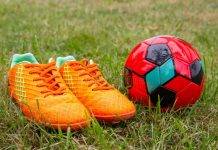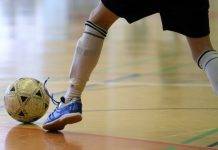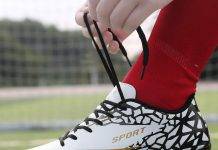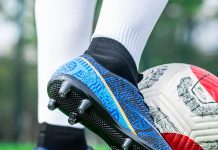Lace up your shoes and get ready to hit the field! In our latest article, we explore the subtle signs that indicate it might be time to retire those old cleats and opt for a new pair. With a focus on safety and performance, we’ll guide you through the telltale signals that your trusted footwear is calling for a replacement. From wear and tear to decreased traction, we’ve got you covered – so you can keep playing at your best.
Worn Out Treads
When the treads on your cleats begin to show signs of wear and tear, it is a clear indication that they need to be replaced. The treads on cleats are designed to provide grip and traction, allowing athletes to maintain stability and control on the field or court. Over time, the constant pressure and friction from running, stopping, and changing directions can cause the treads to wear down. This loss of grip can be dangerous, as it increases the risk of slipping, sliding, and losing balance during gameplay. If you notice that the treads on your cleats are smooth or worn down, it is time to invest in a new pair to ensure your safety and performance.
Review contents
Loss of Grip
One of the most noticeable signs that cleats need to be replaced is a loss of grip. As the treads wear down, the traction they provide decreases significantly. This can be particularly problematic when playing on wet or slippery surfaces. Without proper grip, it becomes more difficult to maintain stability, make quick movements, and change directions with confidence. If you find yourself slipping or sliding during gameplay, it could be a clear indication that your cleats are no longer providing the necessary traction and it is time for a replacement.
Visible Wear and Tear
Another sign that cleats need to be replaced is visible wear and tear on the treads. As you use your cleats over time, the constant running, jumping, and pivoting can cause the treads to become eroded or smooth. This can be seen through a lack of texture or depth in the treads. Additionally, you may notice certain areas of the treads wearing down more than others. This uneven wear pattern can further contribute to a loss of grip and stability. If you observe any significant wear and tear on the treads of your cleats, it is essential to prioritize the safety of your feet and invest in a fresh pair.
Loose or Missing Studs
Studs play a crucial role in providing traction on various surfaces. They dig into the ground, providing stability and preventing slipping. However, over time, these studs can become loose or even go missing completely. When this happens, it is time to consider replacing your cleats.
Loose Studs
If you notice that the studs on your cleats are wobbly or move around when pressure is applied, they are likely loose. Loose studs can cause instability, affecting your balance and potentially leading to injuries. Furthermore, they can compromise the overall performance of your cleats, as they no longer provide consistent traction. If you find that the studs on your cleats are loose, it is advisable to seek a replacement pair to ensure your safety and optimize your gameplay.
Missing Studs
While loose studs are problematic, missing studs are an even greater cause for concern. If you happen to notice any empty stud holes or notice that certain studs are completely absent, it is crucial to replace your cleats immediately. Missing studs drastically reduce the traction of your cleats, making it difficult to maintain stability and control on the field. Without the necessary studs, you may find yourself slipping and sliding, increasing the risk of injury. To prevent accidents and maintain optimal performance, it is advisable to invest in a new pair of cleats when you observe missing studs.
Damage to the Upper
The upper part of cleats, which includes the material covering the top of your foot, can also indicate the need for replacement when damaged. The upper provides foot support and protection, so any cracks, tears, or separation between the upper and sole should be addressed promptly.
Cracks or Tears
Cracks or tears in the upper of your cleats can significantly impact their performance and longevity. As the upper material deteriorates, it may lose its ability to provide adequate support and protection to your feet. Cracks or tears can compromise the structural integrity of the cleat, leading to further damage and potential discomfort. If you notice any visible cracks or tears in the upper, it is best to replace your cleats to prevent these issues from worsening and to ensure the safety of your feet.
Separated Upper and Sole
If you spot any separation between the upper and the sole of your cleats, it is a clear sign that they need to be replaced. The upper and sole work together to provide stability, support, and shock absorption. When the upper becomes detached from the sole, it compromises the overall structure of the cleat. This can result in reduced performance, discomfort, and an increased risk of tripping or falling. To prevent further damage and maintain optimal functionality, it is essential to retire cleats with a separated upper and sole.
Inadequate Cushioning
Proper cushioning in cleats is crucial for shock absorption, reducing the impact on your feet and joints during strenuous physical activities. Without adequate cushioning, you may experience discomfort, pain, and potential injuries.
Decreased Shock Absorption
One of the key functions of cushioning in cleats is shock absorption. Over time, the cushioning material can become compressed and lose its ability to absorb and disperse the impact caused by running or jumping. Consequently, you may begin to feel excessive strain on your feet and joints, leading to discomfort or potential injuries. If you notice a decrease in shock absorption while wearing your cleats, it is time to consider replacing them to prevent further stress on your body.
Visible Compression
Another indicator that your cleats might need replacing is visible compression of the cushioning material. When the cushioning becomes visibly compressed, it suggests that it may have worn out or lost its ability to provide adequate support and shock absorption. This can lead to discomfort, decreased performance, and an increased risk of injury. By investing in a new pair of cleats, you can ensure proper cushioning and maintain the necessary support for your feet and joints.
Pain or Discomfort
Experiencing pain or discomfort while wearing cleats is a significant sign that they need to be replaced. Pain can arise in various areas, including the feet and joints, indicating that your current cleats are no longer providing the necessary support and comfort.
Foot Pain
If you are experiencing consistent foot pain, it is likely that your cleats are not fitting properly or are no longer providing adequate support. Ill-fitting cleats can cause discomfort, blisters, or even more severe foot issues. When shopping for new cleats, consider getting properly measured and investing in a pair that suits your foot shape and size. This will help alleviate any foot pain and ensure a more comfortable and enjoyable sporting experience.
Joint Pain
Joint pain, particularly in the ankles or knees, can also be a sign that your current cleats are no longer suitable for your needs. Aging cleats or those lacking proper cushioning and support can place excess stress on your joints, leading to discomfort or even injury. It is essential to prioritize your joint health and replace your cleats if you notice persistent joint pain. Look for cleats that offer enhanced cushioning and support to alleviate the strain on your joints and allow for pain-free participation in sports activities.
Unstable or Unbalanced Feel
Feeling unstable or off-balance while wearing your cleats can significantly hinder your performance and increase the risk of injuries. Several factors can contribute to this sensation, including lateral instability and uneven foot placement.
Lateral Instability
Lateral instability refers to the difficulty in maintaining stability when moving side to side, such as during quick turns or sudden changes in direction. If your cleats no longer provide the necessary lateral support, you may experience a wobbling or shifting sensation, affecting your balance and limiting your agility. If you notice a lack of stability when making lateral movements, it is time to consider replacing your cleats with a pair that offers better sidewall support and stability features.
Uneven Foot Placement
Uneven foot placement is another factor that can contribute to an unstable or unbalanced feel while wearing cleats. If you notice that your cleats are causing your feet to tilt inward or outward excessively, it can affect your gait and overall stability. This imbalance can lead to discomfort, strain on the ankles, and compromised performance. It is advisable to seek cleats that offer proper alignment and accommodate your foot’s natural positioning to maintain stability and prevent any potential injuries.
Decreased Performance
When cleats are no longer performing at their optimal level, it is a clear indication that they need to be replaced. Decreased performance can manifest in various ways, including slipping, sliding, and impaired agility or speed.
Slipping or Sliding
If you find yourself slipping or sliding during gameplay despite your best efforts, it is likely because your cleats are no longer providing the necessary traction. As treads wear down or studs become loose or missing, the grip is compromised, making it difficult to maintain control and execute quick movements. Slipping or sliding can significantly impact your performance, potentially leading to missed opportunities, reduced efficiency, and an increased risk of injury. To regain stability and improve your performance, it is crucial to replace your cleats when you notice these signs.
Impaired Agility or Speed
Impaired agility or reduced speed can also indicate that your cleats are past their prime. As cleats age and wear down, they may lose their ability to provide the necessary support and responsiveness for quick movements. This can make it challenging to change directions swiftly, affect your ability to cut or pivot effectively, and hinder your overall speed on the field or court. If you feel like your agility or speed has decreased, it may be time to invest in a new pair of cleats that can enhance your performance and help you reach your full potential.
Excessive Odor
If you notice a persistent foul smell emanating from your cleats, it is a clear indication that they need to be replaced. Excessive odor is often associated with the presence of bacteria, mold, or mildew, typically caused by moisture buildup within the cleats.
Persistent Foul Smell
When you consistently detect a strong, unpleasant odor even after cleaning your cleats, it indicates that the odor-causing bacteria or fungi have penetrated the material. Bacteria thrive in warm, moist environments, and when sweat accumulates within the cleats, it becomes an ideal breeding ground. These bacteria release unpleasant odors, making your cleats unwearable and potentially hazardous to your foot health. If you find that your cleats emit a persistent foul smell, it is time to retire them and invest in a fresh pair to maintain hygiene and prevent any fungal or bacterial infections.
Signs of Mold or Mildew
Aside from the odor, visible signs of mold or mildew within your cleats are clear indications that they need to be replaced. Mold and mildew can grow in damp, dark environments, making sweaty cleats an ideal breeding site. These fungi can cause allergic reactions and skin irritations, posing a risk to your foot health. If you notice any visible signs of mold, mildew, or discoloration within your cleats, it is essential to replace them promptly and take preventative measures to ensure proper ventilation and moisture control in your new pair.
Excessive Weight
Over time, cleats can accumulate dirt, sweat, and debris, resulting in increased weight. Excessive weight can hinder your performance and make it more challenging to move efficiently on the field or court.
Noticeable Heaviness
If you find that your cleats feel noticeably heavier than when you first purchased them, it may be an indication of dirt, sweat, or debris buildup. This accumulation can make your cleats feel burdensome and affect your agility and speed. Additionally, the added weight can put additional strain on your feet and joints, potentially leading to discomfort and fatigue. To ensure optimal performance and comfort, it is advisable to replace your cleats when you notice a significant increase in their weight.
Weight Imbalance
Weight imbalance is another issue that can arise due to excessive weight in your cleats. If one cleat feels noticeably heavier than the other, it can affect your balance and potentially lead to an increased risk of injuries. This issue may occur due to unequal dirt or debris accumulation or uneven wear and tear. To maintain stability and minimize the risk of falls or accidents, it is crucial to replace your cleats when you notice a noticeable weight imbalance between the pair.
Outdated Technology
Technology in sports equipment is constantly evolving to improve performance, comfort, and safety. If your cleats are outdated, lacking innovative features, or have an obsolete cleat design, it may be time to upgrade to a new pair.
Obsolete Cleat Design
An obsolete cleat design can limit your performance and place unnecessary strain on your feet and joints. As advances are made in sports footwear technology, older cleat designs may lack the necessary features and improvements. For example, outdated cleat designs may not offer adequate traction, cushioning, or foot support, affecting your overall gameplay. If you find yourself using cleats that are outdated compared to the current market standards, it is advisable to invest in a pair with a modern design that incorporates the latest technology and advances.
Lack of Innovative Features
Newer cleats often incorporate innovative features that can enhance performance and provide added comfort and protection. From improved traction systems to advanced cushioning materials, these features can significantly impact your gameplay and overall experience. If your current cleats lack these innovative features, it may be time to consider upgrading. By investing in a pair that incorporates the latest advancements in sports footwear, you can optimize your performance, reduce the risk of injuries, and elevate your overall comfort while on the field or court.
In conclusion, recognizing the signs that cleats need to be replaced is crucial for maintaining optimal performance and preventing injuries. From worn out treads to damage in the upper, inadequate cushioning to pain or discomfort, and excessive odor to outdated technology, each sign indicates a decline in the functionality and safety of your cleats. By promptly replacing worn-out cleats with a new pair that offers the necessary support, grip, and comfort, you can enhance your performance, prevent injuries, and enjoy your favorite sports or activities to the fullest. Remember to prioritize your foot health and always choose cleats that match your specific needs and preferences to ensure a positive and enjoyable sporting experience.





































